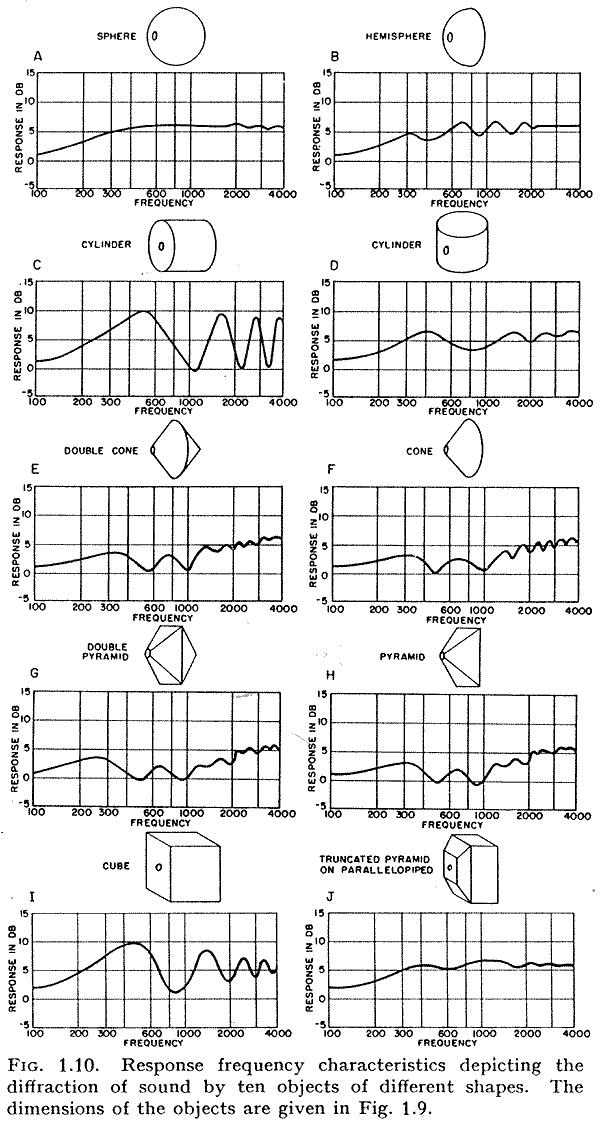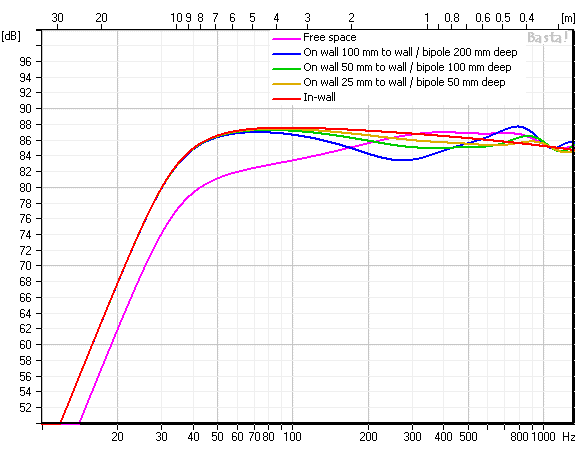Hi 
First post I have started to plan my first "real" speaker build. With "real" I mean actually doing some calculations and not just put an old recycled woofer in a cabinent with some guessed measurements.
I have started to plan my first "real" speaker build. With "real" I mean actually doing some calculations and not just put an old recycled woofer in a cabinent with some guessed measurements.
Since current living condition is limiting the space a bit, the plan is a pair of slim wall speakers for a rather small room. Volym about 3-4 L (or 0,10-0,15 ft3) with dimensions around 55x17x8 cm (or 22x7x3 inches).
My main question:
I have read up on crossovers and played around in Xsim a bit. Started to find something quite good, but then I learned about baffle step. And to me it seems like if I'm going to design my own crossover, I might as well include a BSC. But then I also read about bass support from walls when speakers is situationed close to wall. How do I simulate these two things at the same time?? Haven't find a good guide on this, but I'm thinking it must have been done before?
I don't have equipment to measure and I want to order both drivers and components at the same time. I know that I otherwise could have build the cabinent, measured in place, and then designed the crossover... but this is going to be a design made in theory...
Second question:
I have focused in on the Dayton Audio TCP115 to use as woofer, and pair it with a bit more expensive tweeter that can be crossed over relatively low (approx. 2k). The reason being that this woofer simulates well in small cabinets, and is supposed to be able to play down to 55 Hz in my preliminary design. But does it sound good? After all, it's very cheep... I probably going to build subwoofer next, so maybe it's unneccessary to aim so low? Better to maybe aim at say 65-75 Hz, and have higher sound quality?
Suggestion on drivers?
As info, speakers will be powered from a Rotel RA-03.
(I have also played around with the idea of a small line array But then I'm guessing both the high's and the low's will suffer.)
But then I'm guessing both the high's and the low's will suffer.)
Thank you for answers!
First post
Since current living condition is limiting the space a bit, the plan is a pair of slim wall speakers for a rather small room. Volym about 3-4 L (or 0,10-0,15 ft3) with dimensions around 55x17x8 cm (or 22x7x3 inches).
My main question:
I have read up on crossovers and played around in Xsim a bit. Started to find something quite good, but then I learned about baffle step. And to me it seems like if I'm going to design my own crossover, I might as well include a BSC. But then I also read about bass support from walls when speakers is situationed close to wall. How do I simulate these two things at the same time?? Haven't find a good guide on this, but I'm thinking it must have been done before?
I don't have equipment to measure and I want to order both drivers and components at the same time. I know that I otherwise could have build the cabinent, measured in place, and then designed the crossover... but this is going to be a design made in theory...
Second question:
I have focused in on the Dayton Audio TCP115 to use as woofer, and pair it with a bit more expensive tweeter that can be crossed over relatively low (approx. 2k). The reason being that this woofer simulates well in small cabinets, and is supposed to be able to play down to 55 Hz in my preliminary design. But does it sound good? After all, it's very cheep... I probably going to build subwoofer next, so maybe it's unneccessary to aim so low? Better to maybe aim at say 65-75 Hz, and have higher sound quality?
Suggestion on drivers?
As info, speakers will be powered from a Rotel RA-03.
(I have also played around with the idea of a small line array
Thank you for answers!
If the speaker is completely dependent on the wall, if it blends perfectly, then there is no BSC. Anything else is a compromise situation.I might as well include a BSC. But then I also read about bass support from walls when speakers is situationed close to wall. How do I simulate these two things at the same time?
If the speaker is completely dependent on the wall, if it blends perfectly, then there is no BSC.
+1
Baffle Diffraction Step
there are a number of articles following.
dave
See the driver below - available in Europe, cheap, can do sealed in a somewhat semi-compact enclosure. To make it slimmer, you can do a cutout on the backpanel and put the magnet in, then seal around it - saves 12-16mm  On top of it you can try a Faital 3FE22 - also cheap, available in Europe, sounds good enough and has a neodymium magnet to free up some air in the box. You may need to pad it down a bit.
On top of it you can try a Faital 3FE22 - also cheap, available in Europe, sounds good enough and has a neodymium magnet to free up some air in the box. You may need to pad it down a bit.
https://www.monacor.com/products/components/speaker-technology/hi-fi-speakers/sp-60-8/?r=pdf
https://www.monacor.com/products/components/speaker-technology/hi-fi-speakers/sp-60-8/?r=pdf
Last edited:
To make it slimmer, you can do a cutout on the backpanel and put the magnet in, then seal around it - saves 12-16mm
But if you make the depth too small you will get colouration from reflections of the back wall thru the cone. I would not recommend this.
dave
Both of which are not the right way to go for this project as I'm seeing it. Wall speakers are complicated and in reality simming is going to be much more difficult than measuring, it may not be possible to sim it accurately with existing tools.q77 said:I'm looking for a step-by-step guide on how to simulate a crossover with both room gain and baffle step.
How do I simulate these two things at the same time?? Haven't find a good guide on this, but I'm thinking it must have been done before?
Try Jeff Bagby's Response Modeler. You need Excel though. Let me know if you get that up and running and I can give you some further instructions.
Otherwise, VituixCAD is a newer all-in-one piece of software that includes baffle diffraction and appears to include boundary reinforcement as well, but I haven't used this 1 yet so I can't help with the smaller details.
Essentially there are 3 parts to baffle diffraction:
1- small peaks and dips in the highest frequencies
2- a larger 1-3dB peak usually somewhere in the mids around 1000Hz depending on the baffle width
3- the 6dB loss in the lower frequencies due to different spacial loading
When you put the speaker up against the wall, you lose #3 above, the 6db loss but this can vary a little again with baffle width. So in terms of your sims with the speaker right up against the wall, you want to include the first 2 parts but not the 3rd part of the diffraction response to get the best accuracy you can.
See the graphs in the 1st post of this link for a visual representation of what's happening.
I have focused in on the Dayton Audio TCP115 ..... But does it sound good?
I haven't used this personally, but it is getting good reviews from those that do. Two to 2.5L seems to be ideal.
4/ and a bunch of ripple in the response depending on the shape of the baffle

In the case of a wall mounted speaker, if sufficiently wide and shallow, the wavelengths of the issue become low enuff that the wall looks like an extension of the baffle and they all go away.
If not you get what i call “bipole dip” from the reflection off the wall being out-of-phase with the front radiation.

dave

In the case of a wall mounted speaker, if sufficiently wide and shallow, the wavelengths of the issue become low enuff that the wall looks like an extension of the baffle and they all go away.
If not you get what i call “bipole dip” from the reflection off the wall being out-of-phase with the front radiation.
dave
Yes. very much.
Too quote myself:
It all has too do with size of the wavelengths related to the box dimensions. The wider the baffle, and the shallower it is, the more the wall just starts to seem like part of the baffle.
dave
Too quote myself:
In the case of a wall mounted speaker, if sufficiently wide and shallow, the wavelengths of the issue become low enuff that the wall looks like an extension of the baffle and they all go away.
It all has too do with size of the wavelengths related to the box dimensions. The wider the baffle, and the shallower it is, the more the wall just starts to seem like part of the baffle.
dave
Tha would be the way to go to optimise for diffraction on any speaker… a hemisphere, if in free air needs to be terminated on the backside by another hemisphere, or better yet an egg shape or one like the mid box in the B&W Nautilus.
Heavy chamfers are easier, and the sides are most important, with the top next.
We do big side chamfers on our full-on miniOnkens. It makes a big difference (as in subtle details are enhanced).
dave
Heavy chamfers are easier, and the sides are most important, with the top next.
We do big side chamfers on our full-on miniOnkens. It makes a big difference (as in subtle details are enhanced).
dave
...if in free air needs to be terminated on the backside by another hemisphere, or better yet an egg shape or one like the mid box in the B&W Nautilus.
One glaring omission I thought was not testing the truncated pyramid front and back. Should be easier to diy than a sphere.
Yes, the diffraction is reflected back by the wall.Negative effects?
dave
- Status
- This old topic is closed. If you want to reopen this topic, contact a moderator using the "Report Post" button.
- Home
- Loudspeakers
- Multi-Way
- First build: Slim wall speakers. Some startup questions